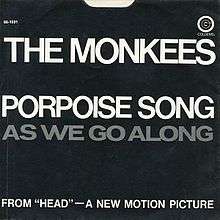Porpoise Song (Theme from Head)
| "Porpoise Song" | ||||
|---|---|---|---|---|
 US single cover | ||||
| Single by The Monkees | ||||
| from the album Head | ||||
| B-side | "As We Go Along" | |||
| Released | 5 October 1968 | |||
| Format | 7" | |||
| Recorded |
26 and 28 February 1968 California Recorders Hollywood, CA | |||
| Genre | ||||
| Length | 4:00 | |||
| Label | Colgems #1031 | |||
| Writer(s) | ||||
| Producer(s) | Gerry Goffin | |||
| The Monkees singles chronology | ||||
| ||||
"Porpoise Song (Theme from Head)" is a song written by Gerry Goffin and Carole King and performed by pop/rock quartet The Monkees on their album Head. The song was commissioned by Bob Rafelson, the director and producer of the film Head.[1] The song was released as a single in 1968, and reached No. 62 on the Billboard Hot 100. The single version runs over a minute longer than the album version.
The song’s lyrics and melody echoes the psychedelic vibe of mid-1960s rock music. Micky Dolenz provides the vocals, which are distorted by echoing effect, and a mix of organ riffs, cello, string-bass, woodwinds and horns float in and out of the tune. The lyrics call into question the order of the world and one’s place therein, and there are also veiled in-joke references to Dolenz’s childhood work as the star of the television series Circus Boy.[2][3][4]
The song was produced by its co-writer Gerry Goffin on 26, 28 and 29 February 1968. The track includes chimes, tubular bells and aquatic sound effects. "Without a doubt, this is the most elaborate production ever for a Monkees recording."[5]
According to Bob Rafelson:
Carole King was living in an apartment building on Sunset Boulevard, and I went to her apartment every day, and we would sit and we would talk. That song was critical to me. 'A face, a voice, an overdub has no choice.' In other words, the whole synthetic process of making The Monkees' records was about to be [examined] in the movie. They are constantly being picked up, used, transplanted, subjected to influence by the [guru], by the war, by the media, and all of these things are exposed. They are always [portrayed] as the victims of their own fame. That's what I chose to make the movie about.... It was Carole or Gerry's idea to record live porpoise sounds and use them on the track. That's what you hear [at the end of the song]. I just thought that they were the appropriate people. It is far and away my favourite Monkees' song.[6]
In the Monkees' 1968 feature film Head, the song appears at the beginning and the end of the production. At the start of the film, the group are being chased after, running onto a bridge. In an attempt to escape, Dolenz jumps from the bridge as the others look on in shock. As Dolenz sinks, he's saved from drowning by a couple of beautiful mermaids. At the end of the film, the other members follow Dolenz and jump from the bridge. As they appear to swim to shore, they end up in a large water tank. Solarization visual effects are used on screen to mirror the psychedelic nature of the song’s lyrics.[7]
The song also appears on several "greatest hits" albums by The Monkees. It was featured in Vanilla Sky, a 2001 film with Tom Cruise, Penélope Cruz and Cameron Diaz, and Season 6 episode 12 ("The Quality of Mercy") of Mad Men.
Covers by other artists
- 1988: Bongwater on the 7" limited-edition single "You Don't Love Me Yet", Shimmy 7-98
- 1995: Trouble on the album Plastic Green Head
- 1996: The Wondermints on the album Wonderful World of The Wondermints
- 1997: The Lightning Seeds as a B-side to the single "Sugar Coated Iceberg"
- 1999: The Church on the album A Box of Birds
- 2000: The Grapes Of Wrath on the album Extended Field Trip
- 2003: DJ Nobody (also known as Elvin Estela, later of Blank Blue) on the album Pacific Drift: Western Water Music, Vol. 1
- 2004: ...And You Will Know Us By the Trail of Dead, both live and on their 2004 EP Worlds Apart
- 2010 Andrew WK, live
- 2014: Django Django, as part of the 'Late Night Tales' series
- 2014: Progressive rock band Glass Hammer, on the album Ode to Echo
- 2014 - 2015: The Polyphonic Spree, Live
References
- ↑ Liner notes Head Handmade |author=Sandoval, Andrew |publisher=Rhino Records
- ↑ Pamela RobertsonWojcik (2002). Soundtrack Available: Essays on Film and Popular Music. Duke University Press. p. 94. ISBN 0-8223-2797-X.
- ↑ James E. Perrone (2006). The Words and Music of Carole King. PraegerPublishers. p. 16. ISBN 0-275-99027-3.
- ↑ Jim DeRogatis (2003). Turn On Your Mind: Four Decades of Great Psychedelic Rock. Hal Leonard. p. 638 pages. ISBN 0-634-05548-8.
- ↑ Andrew Sandoval (2005). The Monkees - The day-by-day story of the '60s TV pop sensation. Thunder Bay Press. p. 177. ISBN 1-59223-372-4.
- ↑ Liner Notes Head Handmade | Author=Andrew Sandoval | publisher=Rhino Records
- ↑ Bill Gibron (July 27, 2007). "A 'Head' of its Time". PopMatters.com. Retrieved 2009-10-05.